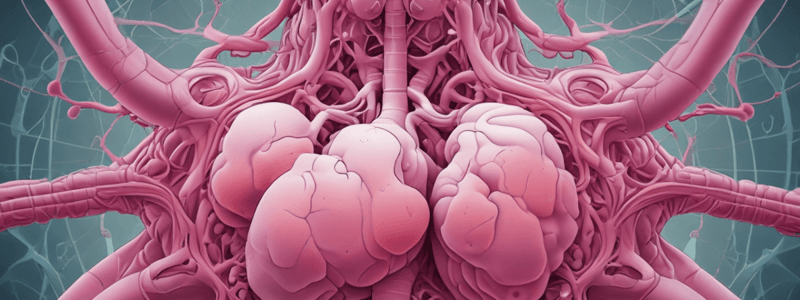Podcast
Questions and Answers
What is the approximate percentage of alveolar surface composed of simple squamous epithelium?
What is the approximate percentage of alveolar surface composed of simple squamous epithelium?
- 5%
- 95% (correct)
- 20%
- 50%
What type of fibers circumscribe the orifices of alveoli?
What type of fibers circumscribe the orifices of alveoli?
- Elastic and reticular fibers (correct)
- Collagen fibers
- Smooth muscle fibers
- Nervous fibers
What is the function of type I pneumocytes in preventing the seepage of extracellular fluid into the alveolar lumen?
What is the function of type I pneumocytes in preventing the seepage of extracellular fluid into the alveolar lumen?
- They produce surfactant
- They form occluding junctions with each other (correct)
- They migrate between type II pneumocytes
- They phagocytose particulate matter
Which type of pneumocytes have membrane-bound lamellar bodies that contain pulmonary surfactant?
Which type of pneumocytes have membrane-bound lamellar bodies that contain pulmonary surfactant?
What is the role of alveolar macrophages in the alveolus?
What is the role of alveolar macrophages in the alveolus?
In patients with emphysema, what is decreased in the lung tissue?
In patients with emphysema, what is decreased in the lung tissue?
What is the narrowest barrier region in the lung?
What is the narrowest barrier region in the lung?
What is the primary mechanism of O2 and CO2 exchange in the lungs?
What is the primary mechanism of O2 and CO2 exchange in the lungs?
What is the function of the visceral pleura?
What is the function of the visceral pleura?
What is the main difference between the left and right thoracic cavities?
What is the main difference between the left and right thoracic cavities?
What type of blood does the pulmonary artery supply to the lungs?
What type of blood does the pulmonary artery supply to the lungs?
What is the primary function of the bronchial arteries?
What is the primary function of the bronchial arteries?
What happens to the smooth muscle coats in individuals with asthma?
What happens to the smooth muscle coats in individuals with asthma?
What is the effect of steroids and β2-agonists on bronchiolar smooth muscle?
What is the effect of steroids and β2-agonists on bronchiolar smooth muscle?
What is the characteristic of the pulmonary circulation?
What is the characteristic of the pulmonary circulation?
Flashcards are hidden until you start studying
Study Notes
Alveoli Structure
- Alveoli have a prominent basal lamina
- Alveoli openings are associated with alveolar sacs
- Devoid of smooth muscle cells, instead circumscribed by elastic and reticular fibers
Type I Pneumocytes
- Compose ~95% of the alveolar surface
- Simple squamous epithelium
- Form occluding junctions with each other to prevent fluid seepage
- Adluminal aspect covered by a well-developed basal lamina
- Luminal aspect lined by surfactant
Type II Pneumocytes
- Compose ~5% of the alveolar surface
- Dome-shaped apical surface juts into the alveolar lumen
- Contain membrane-bound lamellar bodies with pulmonary surfactant
- Synthesized on the RER and modified in the Golgi apparatus
Alveolar Macrophages
- Derived from monocytes that gain access to the pulmonary interstitium
- Migrate between type I pneumocytes and enter the alveolar lumen
- Phagocytose particulate matter in the alveolar lumen and interalveolar spaces
- Assist type II pneumocytes in the uptake of surfactant
Gas Exchange
- O2 is exchanged for CO2 carried by blood in the lungs
- CO2 is exchanged for O2 carried by blood in the tissues
- Passage of O2 and CO2 across the blood-gas barrier is due to passive diffusion
- Narrowest barrier regions consist of surfactant, type I pneumocytes, fused basal laminae, and endothelial cells
Thoracic Cage
- Divided into three regions: left thoracic cavity, right thoracic cavity, and mediastinum
- Each thoracic cavity is lined by a serous membrane (pleura) consisting of simple squamous epithelium and subserous CT
Pulmonary and Bronchial Arteries and Veins
- Pulmonary arteries arise from the right ventricle and drain into the left atrium
- Supply deoxygenated blood to the lungs from the right side of the heart
- Involved in gas exchange and are a low-pressure system
- Bronchial arteries arise from the systemic circulation and carry oxygenated blood
- Travel in the septa between lobules of the lung and are a high-pressure system
Innervation of the Lungs
- Parasympathetic, preganglionic fibers descend into the vagus and terminate in the ganglia
- Ganglia contain excitatory, cholinergic neurons and inhibitory, nonadrenergic neurons
- Postganglionic fibers to the smooth muscle are excitatory or inhibitory
Asthma
- Smooth muscle coats contract at the end of expiration and relax during inspiration
- In asthma, the smooth muscle coat undergoes prolonged contraction during expiration
- Steroids and β2-agonists relax bronchiolar smooth muscle and are frequently used to relieve asthmatic attacks
Studying That Suits You
Use AI to generate personalized quizzes and flashcards to suit your learning preferences.




